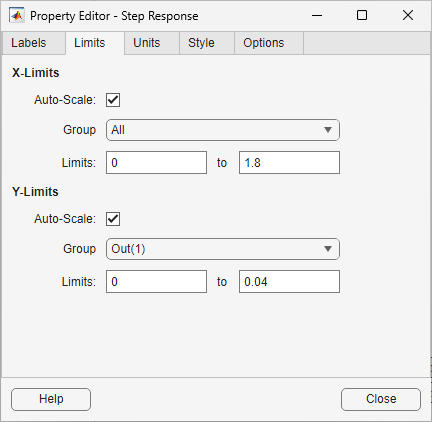Customize Linear Analysis Plots Using Property Editor
After you create a linear analysis response plot, you can interactively edit the plot using the Property Editor dialog box. To open the Property Editor, do one of the following:
Double-click in the plot region.
Right-click the plot, and select Properties from the context menu.
If you plot multiple responses in the same figure, you can edit the properties for each plot individually.
You can also modify response plot properties:
At the command line. For more information, see Customize Linear Analysis Plots at Command Line (Control System Toolbox).
Using the Property Inspector.
Opening the Property Editor
As an example of a response plot, consider the following step response.
sys_dc = idtf([1 4],[1 20 5]); stepplot(sys_dc)

Overview of Property Editor
The appearance of the Property Editor dialog box depends on the type of response plot.
In general, you can change the following properties of response plots. Only the Labels and Limits tabs are available when using the Property Editor with Simulink® Design Optimization™ software.
Titles and X- and Y-labels on the Labels tab.
Numerical ranges of the X and Y axes on the Limits tab.
Units where applicable (e.g., rad/s to Hertz) on the Units tab.
If you cannot customize units, the Property Editor displays that no units are available for the selected plot.
Styles on the Styles tab.
You can show a grid, adjust font properties, such as font size, bold, and italics, and change the axes foreground color
Change options where applicable on the Options tab.
These include peak response, settling time, phase and gain margins, etc. Plot options change with each plot response type. The Property Editor displays only the options that make sense for the selected response plot. For example, phase and gain margins are not available for step responses.
The Property Editor and its associated plot are dynamically linked. As you make changes in the Property Editor, the response plot updates immediately. Conversely, if you make changes in a plot using right-click menus, the Property Editor for that plot automatically updates.
Labels tab
To specify new text for plot titles and axis labels, type the new names in the field next to the label you want to change. The label changes immediately as you type, so you can see how the new text looks as you are typing.

Limits tab
Default values for the axes limits make sure that the maximum and minimum x and y values are displayed. To override the default settings, change the values in the Limits fields. The Auto-Scale box automatically clears if you specify a limit value. The new limits appear immediately in the response plot.
To reset the limits to the default values, select the Auto-Scale parameter.
For MIMO systems, you can configure different limits for each input or output. You can also use the same limits for all inputs or all outputs. In the Group drop-down lists, select:
All to specify limits for all inputs or all outputs.
An individual input or output to specify different limits. Once you specify options for a specific input or output, the corresponding limits for the All option are cleared.

Units tab
You can use the Units tab to change units in your response plot. The contents of this tab depend on the response plot associated with the editor. Use the drop-down lists to select values for each type of unit.

Response Plot | Unit Properties |
|---|---|
Bode and |
|
Impulse |
|
Nichols Chart |
|
Nyquist Diagram |
|
Pole/Zero Map |
|
Singular Values |
|
Step |
|
Style tab
Use the Style tab to toggle grid visibility and set font preferences and axes foreground colors for response plots.

You have the following choices:
Grid — Activate grids by default in new plots.
Fonts — Set the font size, weight (bold), and angle (italic) for fonts used in response plot titles, X/Y-labels, tick labels, and I/O names. Select font sizes from the menus or type any font-size values in the fields.
Colors — Specify the color vector to use for the axes foreground, which includes the X-Y axes, grid lines, and tick labels. Use a three-element vector to represent red, green, and blue (RGB) values. Vector element values can range from 0 to 1.
If you do not want to specify RGB values numerically, click Select to open the Color dialog box.
Options tab
The Options tab enables you to customize response characteristics for plots. Each response plot has its own set of characteristics and optional settings. When you change the value in a field, press Enter to update the response plot.

Response Characteristic Options for Response Plots
Plot | Customizable Feature |
|---|---|
Bode Diagram and Bode Magnitude |
|
Impulse |
|
Nichols Chart |
|
Nyquist Diagram |
|
Pole/Zero Map |
|
Singular Values | None |
Step |
|
